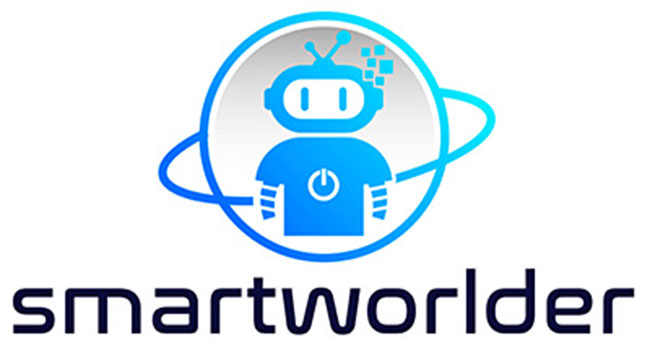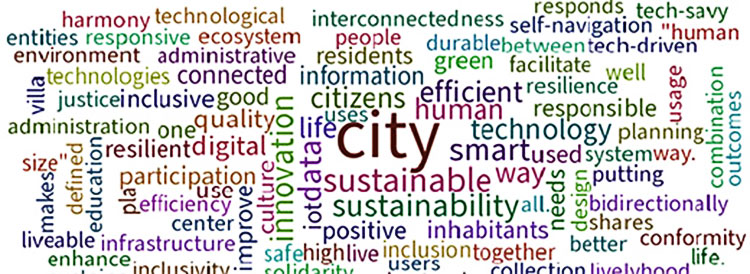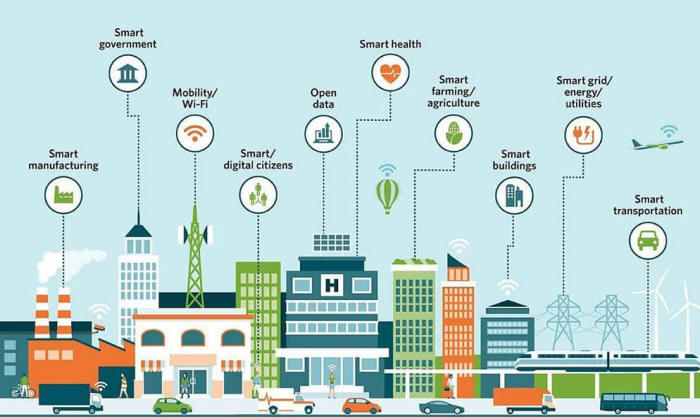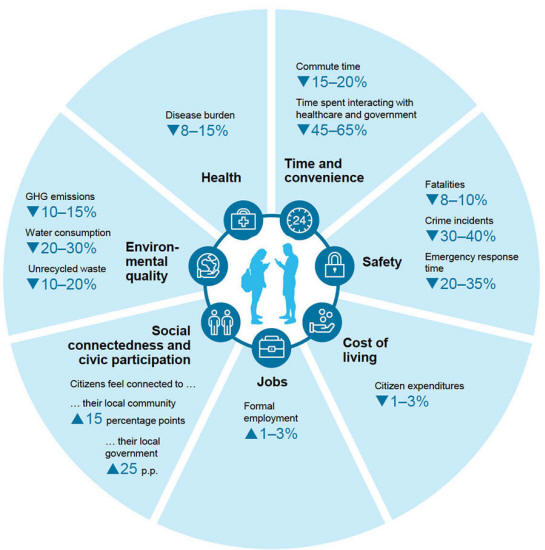|

by Nanotechnology
Spotlight Guest Authors
September
22, 2021
from
NanoWerk Website

What is driving the emergence of Smart Cities?
By 2050, cities will be home to almost 70% of the world's
population. Compared with today, this will add another 2.5 billion
people to urban areas.
According to the UN, today the most urbanized
regions include,
-
Northern America (with 82% of its population living
in urban areas in 2018)
-
Latin America and the Caribbean (81%)
-
Europe (74%)
-
Oceania (68%)
-
The level of urbanization in Asia is
now approximating 50%
By 2030, the world is projected to have 43
megacities with more than 10 million inhabitants, most of them in
developing regions.
As the world continues to urbanize, sustainable development depends
increasingly on the successful management of urban growth,
especially in low-income and lower-middle-income countries where the
pace of urbanization is projected to be the fastest.
Many countries
will face challenges in meeting the needs of their growing urban
populations, including for housing, transportation, energy systems
and other infrastructure, as well as for employment and basic
services such as education and health care.
The world's cities occupy just 3 per cent of the Earth's land, but
account for 60-80% of energy consumption and 75% of carbon
emissions.
These growing urban centers face increasing environmental
pressures and infrastructure needs - and growing demands from
residents to deliver a better quality of life and to do so at a
sustainable cost.
A smart city is an infrastructure framework that addresses the
growing urbanization challenges by embracing integrated and
automated information and communication technologies to help
optimize all city operations, help achieve sustainability goals and
better quality of life for its citizens.
Simply put:
Smart cities don't just install digital interfaces in
traditional infrastructure or streamline some city operations.
Instead, they use big data analytics and technology to make better
decisions.
There is another determining factor: good management.
Technology is only as effective as the entity that puts it to work.
That means Smart Cities need smart government.
Only by combining smart technologies with
smart governance can you
achieve a more efficient, responsive and sustainable city that
delivers a better quality of life for its residents.

Attendees at an urban knowledge-sharing event
generated this word
cloud when asked to describe
a "smart city" in one word.
(Source:
World Bank Blogs)
What makes a city smart?
Smart cities rely on a range of core technologies that include the
internet of things (IoT), smartphones, a plethora of sensors and
high-speed communication networks.
Utilizing environmental sensors, satellite data like GPS, utility
meters, counters, cameras, and other connected devices has given
cities more expansive data at an unprecedented scale.
That's why layered on top of the IoT network are applications that
translate this vast amount of data - that is continuously collected
- into alerts, insight and actions.
A critical component for a smart city to work is public usage. Many
applications succeed only if they are widely adopted and manage to
change behaviors.
Another important characteristic is that city functions like health
services, transportation or emergency services no longer operate
within their own segregated silos but are all interconnected.
Take this example:
In a smart city, traffic cameras capture traffic
accidents in real time.
AI systems instantly assess possible
implications and automatically alert emergency services,
transportation officials, and car navigation systems in the vicinity
with location coordinates and other relevant information about the
situation.
This fast response could help save lives and reduce
traffic congestion.
At the same time, this information is fed into
other AI systems that continuously process traffic data to
understand changing patterns or emerging problem areas.
They might
even be able to predict accidents.
They use this to propose
improvements to city planners on how to re-engineer road layouts and
traffic signs, traffic routing, traffic signal timing sequences,
issue public alerts or take other pre-emptive actions.
The core infrastructure elements in a Smart City include all basic
city operations:
-
water and electricity supply (smart grids)
-
sanitation including solid-waste management and recycling
-
efficient
urban mobility (smart roads) and public transport
-
affordable
housing
-
robust and fast Internet
-
digitalization of services
(e-Governance) and citizen participation
-
sustainable environment
-
safety and security of citizens
-
health and
education services

Components of a smart city.
(Source: TechTarget)
A smart city infrastructure helps its community to improve things
like energy distribution, streamline trash collection, decrease
traffic congestion, and improve air quality.
For example:
Sensors embedded in roads, streetlights, traffic lights, and cars
continuously send data that allows monitoring systems to change
traffic light cadence and timing to respond to real-time traffic,
reducing road congestion.
These sensor networks also accurately monitor environmental
conditions like air quality, water runoff, fires, or even wildlife
count.
Sensors will also allow structural health monitoring of
infrastructure such as building, roads, dams and bridges.
Connected cars can communicate with parking meters and electric
vehicle charging docks and direct drivers to the nearest available
spot.
Smart garbage cans automatically send data to waste management
companies and schedule pick-up as needed versus a pre-planned
schedule.
A smart utility grid empowers end users to be more aware of their
energy uses and allow utility companies to deliver only as much
energy, water or gas as is needed.
Smart buildings utilize monitoring services that track usage to
optimize electricity demands.
Citizens' smartphone
becomes their mobile driver's license and ID card with digital
credentials, which speeds and simplifies access to city and
local government services.
Technology components of a Smart City
Before a city can become smart, it has to be connected.
The required
digital infrastructure includes a network of data-collecting sensors
and devices, comprehensive broadband and wireless networks, and
platforms on which data can be stored and shared.
Because many
applications require that individuals transmit and receive data
anywhere,
smartphones are a critical component...
IoT
With the rapid build-out of the
Internet of Things (IoT), billions
of "dumb" inanimate objects have become "smart" - that is, they have
been outfitted with sensors and actuators and connected to the
Internet.
The IoT is now at work all around us.
RFID tags in packages track cargo shipments, GPS systems guide
drivers to their destinations, streetlights dim when there is no car
nearby, and smart thermostats turn off heat and air conditioning
when rooms are unoccupied.
Adoption has accelerated as the costs of IoT sensors, processing power, and cloud storage have steadily
fallen.
Communications networks
Whereas IoT devices are the eyes and ears of a smart city,
ubiquitous, stable and fast communication are its backbone. Ideally,
free
Wi-Fi will benefit tourists and residents without access to
affordable mobile data.
Citizens can engage with smart city ecosystems in various ways using
smartphones and other mobile devices, connected cars and homes.
Open data platforms
Smart technologies run on data
- and cities, with their immense scale
and complexity, generate endless streams of it.
Data is generated by
traffic flow, public transit systems, energy demand, crime
incidents, waste disposal, noise, weather patterns, outbreaks of
infectious disease, and countless other aspects of daily city life.
These huge amounts of data only become useful when applications turn
them into useful and actionable information. Open data platforms do
exactly that.
They come in multiple forms, from centralized open
data portals to specialized real-time travel information platforms.
They allow for safe storage and adequate access to the different
data sources that power a smart city, and they can provide the raw
material for ongoing innovation.
The early days of smart city development has led to a misconception
that smart cities are simply local government agencies purchasing
software to operate subway and security systems more efficiently.
But the reality has evolved into something broader and more
collaborative.
City governments do not have to provide every type of
application and service themselves. There is room for private-sector
companies, state-owned utilities, universities, foundations, and
nonprofits to contribute.
The ecosystem has become more intricate
over time, with the degree and mix of private-sector participation
varying from city to city.
Technology is reconfiguring traditional
roles and divisions of labor - and in a smart city, people and private
companies actively participate.
This shift is particularly evident in new types of mobility systems.
-
E-hailing services like Lyft and Uber
-
car sharing services like
Miles and ShareNow
-
on-demand minibus services like Chariot
-
numerous bike and scooter sharing services that have sprung up all
across large cities
Artificial Intelligence
Converting data sets into standardized, sharable formats and making
them available on easy-to-use public portals gives external
developers the raw material for making applications - and in
particular, provides crucial input to AI systems, enabling them to
perform more sophisticated functions.
With
artificial intelligence (AI), computers can analyze and learn from
information at higher accuracy and speed than humans can, leading to
faster and more accurate conclusions and decisions.
Blockchain
Cities have a variety of stakeholders and the exchange of data among
stakeholders is essential for highly convenient urban services.
Blockchain enables network participants to exchange data with a high
degree of reliability and transparency without the need for a
centralized administrator.
Blockchain technology will find a role in several Smart City
applications such as for instance mobility as a service (MaaS).
MaaS
seamlessly connects multiple transportation systems to provide
highly convenient mobility services.
In the realization of MaaS,
there is an effort to use blockchain for data exchange and revenue
sharing among multiple transportation operators, and transportation
may take place across cities.
At the business model layer, it is
necessary to solve the issues of data standardization - for example,
for people movement information and that collected from Internet of
Things (Iota) devices - and those of commercial models, such as how
to distribute revenue among transportation operators.
A similar model could be applied to other sectors like energy.
For
example,
Smart Dubai, is developing use cases for blockchain across
multiple sectors such as finance, education and transportation.
One
of the projects is to facilitate enrollment procedures for students
moving between emirates using blockchain.
APIs
Application programming interfaces (APIs) are a vital component of
smart city development.
APIs allow users to connect directly to the
data they need without repeatedly searching through the huge volume
that is produced.
APIs can also help connect data and devices
together to create a unique, shared information system that smart
city services can be built on.
What are the benefits of smart cities?
Cities are using the data gained from their IoT networks to measure
environmental conditions, set goals, and manage interventions that
result in improvements for residents.
They are tracking their fleets
to optimize operations and implement preventive maintenance.
They
are monitoring the use of energy and water to increase efficiency.
They are analyzing the flow of people to better plan public space.
Research by the
McKinsey Global Institute (MGI) has shown that Smart
City applications can improve some key quality-of-life indicators by
10 to 30 percent from the time they are introduced:

Potential improvement through
current generation of smart city
applications,
from time of implementation.
(Source: McKinsey Global
Institute analysis)
As the MGI report explains,
"The wide range of
outcomes reflects the fact that applications perform differently
from city to city, depending on factors such as legacy
infrastructure systems and on baseline starting points.
Nearly half of the
applications affect more than one aspect of the quality of life.
Intelligent traffic signals, for instance, not only improve
mobility but also lower emissions and make roads safer."
Are Smart Cities Secure?
As with all online systems, there is a risk of,
-
cyber-attacks
-
hacking
-
data theft
At the moment technology is outpacing legal
regulations, but legislation is already being put in place in
different nations, such as the IoT Cybersecurity Improvement Act in
the United States to help determine and establish minimum security
requirements for connected devices in smart cities.
Leading Smart Cities of the World
In 2019, IMD Business School in Switzerland has started to publish a
global ranking of smart cities.
In its second edition, the
IMD Smart
City Index 2020 ranked 109 cities with Singapore as the leading
smart city in the world. (Download the
2020 Smart City Index as PDF)
Singapore
In 2014, the nation state of Singapore created a
Smart Nation
initiative, overseen by a Smart Nation and Digital Government
Office, with the goal to drive pervasive adoption of digital and
smart technologies throughout Singapore.
New York City
NYC has been steadily increasing IoT technologies across the city
with a number of applications. You can download a PDF of the
New
York City Internet of Things Strategy.
Among the City's largest-scale IoT projects is the
Department of
Environmental Protection's (DEP) integration of wirelessly connected
water meters for buildings.
These meters allow DEP to monitor water
usage in over 800 000 buildings across the city, eliminating the
need to send physical inspectors to read meters.
Another large-scale example is the
Department of Citywide
Administrative Services (DCAS)'s implementation of the nation's
largest tracking program for public vehicles.
Dubai
Since its inception in 2015, the
Smart Dubai Office has launched
over 130 initiatives in partnership with government and private
sector entities.
Some key initiatives include,
-
the Dubai Data
Initiative
-
the Dubai Blockchain Strategy
-
the Happiness Agenda
-
the
Dubai AI Roadmap
-
the Dubai Paperless Strategy
And then there are cities that are planned and built from scratch
like
New Songdo City in South Korea that was designed and created to
be a smart city with IoT technology:
computers are built into the
buildings and streets, while sensors gather information on things
like traffic flow and energy use.
Another smart city planned from scratch is
Neom in Saudi Arabia,
which plans to complete its first section by 2025.

New Songdo City
|






